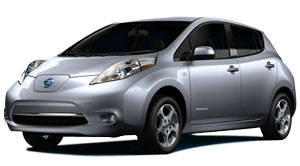Electric vehicles are here to stay. True, they don’t come cheap right now, but like any new technology that costs a fortune upon its introduction and becomes more affordable over the years, so will EVs. Ten years ago, a powerful laptop cost $3,000; today, you can get one for 300 bucks.
The 2012 Nissan LEAF is one of the first mass-produced, 100% electric vehicles available for consumers. After a few days behind the wheel (including a participation in our recent EV comparison test), I realized that this little marvel arguably represents the future of the automobile.
Room for five
Unlike the four-passenger Chevrolet Volt and the Mitsubishi i-MiEV, and like the Ford Focus Electric, the 2012 Nissan LEAF has room for five occupants. What’s especially impressive is the amount of interior room found inside. There’s plenty of elbow room and the cabin feels airy; apart from rather fat A-pillars, outward visibility is excellent, as well.
Soft-touch cloth wraps the seats and trims the door panel and centre armrests, while fit and finish is as good as in any recent Nissan (such as the 2013 Altima). Both front and rear seats are heated, since keeping passengers’ buns warm consumes less energy than the climate control system.
You also get 411 litres of volume in the LEAF’s deep cargo area. Flip the rear seatbacks down and the total space grows to 680 litres; not quite as good as your typical subcompact hatchback, but better than other EVs currently on the market.
Home on the range
Yeah, yeah; about range anxiety: consider it minimal in the 2012 Nissan LEAF, especially after testing the i-MiEV and the Focus Electric. A full charge provides you with about 160 km of range in the Nissan LEAF, as opposed to roughly 100 km in its rivals.
When reading about EVs, you’ll notice a lot of words such as “about,” “approximately,” “more or less” and “roughly,” because available range is all about variables. Driving habits, number of occupants, temperature, hills, highways, and turned-on accessories: all of these factors translate into having to do some calculations.
That’s right: driving an EV on a daily itinerary means you have some planning to do before you head out. That’s a major habit change, and something many of us are not willing to do. The automobile symbolises freedom -- less so in an EV. Still, with 160 km on tap, there’s plenty of juice for the majority of us who drive to work and back, pick up the kids at school, and stop at the grocery store every day.
Plenty of power
The electric motor under the hood of the front-drive 2012 Nissan LEAF produces 107 hp and 207 lb-ft of torque, mated to a single-speed transmission. Zero to 100 km/h takes 9.9 seconds -- which is as quick as your typical subcompact.
Merging on the highway and staying with the flow of traffic is also not a problem in the 2012 Nissan LEAF. The linear power delivered in the LEAF is actually quite fun, and feels livelier than the numbers suggest.
The LEAF emphasises ride comfort, which goes well with the quiet, soothing driving experience. With no gas engine to drown out road noise, Nissan did a good job insulating the cabin so all you hear is the electric motor whine, some tire thumping on rough surfaces, a little wind noise and, well, noisy passengers.
Assumes its role
The 2012 Nissan LEAF doesn’t try to hide its EV status. On the road, you’ll clearly be viewed as an avant-garde citizen, an early adopter of modern technology, and a guinea pig for testing said modern technology.
That’s OK, because behind the wheel of a LEAF you feel purified, cleansed. Squirrels and bunny rabbits and deer salute you as you drive by; flowers bloom, vines grow, leaves turn green, the sky turns blue... Woah, I’m daydreaming here. But I think you get the picture.
The budget
At $38,395, the 2012 Nissan LEAF obviously doesn’t come cheap, although it’s less expensive than the Chevrolet Volt and the Ford Focus Electric. The Mitsubishi i-MiEV is several thousand dollars cheaper, but smaller and with a shorter range. You also have to get a charging station installed at home before Nissan will let you drive away with a LEAF.
Certain provinces currently offer rebates with the purchase of an EV, which makes the high price more digestible. As a consumer, you’ll have to do the math and figure out how much you’ll actually save in fuel. A full charge at home will cost somewhere between $2 and $3. Driving the same distance in a gas-powered subcompact will cost between $12 and $15.
Right now, the LEAF is the all-around best EV you can buy.
The 2012 Nissan LEAF is one of the first mass-produced, 100% electric vehicles available for consumers. After a few days behind the wheel (including a participation in our recent EV comparison test), I realized that this little marvel arguably represents the future of the automobile.
Room for five
Unlike the four-passenger Chevrolet Volt and the Mitsubishi i-MiEV, and like the Ford Focus Electric, the 2012 Nissan LEAF has room for five occupants. What’s especially impressive is the amount of interior room found inside. There’s plenty of elbow room and the cabin feels airy; apart from rather fat A-pillars, outward visibility is excellent, as well.
Soft-touch cloth wraps the seats and trims the door panel and centre armrests, while fit and finish is as good as in any recent Nissan (such as the 2013 Altima). Both front and rear seats are heated, since keeping passengers’ buns warm consumes less energy than the climate control system.
You also get 411 litres of volume in the LEAF’s deep cargo area. Flip the rear seatbacks down and the total space grows to 680 litres; not quite as good as your typical subcompact hatchback, but better than other EVs currently on the market.
Home on the range
Yeah, yeah; about range anxiety: consider it minimal in the 2012 Nissan LEAF, especially after testing the i-MiEV and the Focus Electric. A full charge provides you with about 160 km of range in the Nissan LEAF, as opposed to roughly 100 km in its rivals.
When reading about EVs, you’ll notice a lot of words such as “about,” “approximately,” “more or less” and “roughly,” because available range is all about variables. Driving habits, number of occupants, temperature, hills, highways, and turned-on accessories: all of these factors translate into having to do some calculations.
That’s right: driving an EV on a daily itinerary means you have some planning to do before you head out. That’s a major habit change, and something many of us are not willing to do. The automobile symbolises freedom -- less so in an EV. Still, with 160 km on tap, there’s plenty of juice for the majority of us who drive to work and back, pick up the kids at school, and stop at the grocery store every day.
Plenty of power
The electric motor under the hood of the front-drive 2012 Nissan LEAF produces 107 hp and 207 lb-ft of torque, mated to a single-speed transmission. Zero to 100 km/h takes 9.9 seconds -- which is as quick as your typical subcompact.
Merging on the highway and staying with the flow of traffic is also not a problem in the 2012 Nissan LEAF. The linear power delivered in the LEAF is actually quite fun, and feels livelier than the numbers suggest.
The LEAF emphasises ride comfort, which goes well with the quiet, soothing driving experience. With no gas engine to drown out road noise, Nissan did a good job insulating the cabin so all you hear is the electric motor whine, some tire thumping on rough surfaces, a little wind noise and, well, noisy passengers.
Assumes its role
The 2012 Nissan LEAF doesn’t try to hide its EV status. On the road, you’ll clearly be viewed as an avant-garde citizen, an early adopter of modern technology, and a guinea pig for testing said modern technology.
That’s OK, because behind the wheel of a LEAF you feel purified, cleansed. Squirrels and bunny rabbits and deer salute you as you drive by; flowers bloom, vines grow, leaves turn green, the sky turns blue... Woah, I’m daydreaming here. But I think you get the picture.
The budget
At $38,395, the 2012 Nissan LEAF obviously doesn’t come cheap, although it’s less expensive than the Chevrolet Volt and the Ford Focus Electric. The Mitsubishi i-MiEV is several thousand dollars cheaper, but smaller and with a shorter range. You also have to get a charging station installed at home before Nissan will let you drive away with a LEAF.
Certain provinces currently offer rebates with the purchase of an EV, which makes the high price more digestible. As a consumer, you’ll have to do the math and figure out how much you’ll actually save in fuel. A full charge at home will cost somewhere between $2 and $3. Driving the same distance in a gas-powered subcompact will cost between $12 and $15.
Right now, the LEAF is the all-around best EV you can buy.
Road Tests and Reviews
Experts
Consumers
2012 Nissan LEAF
Review Highlights




Article Gallery



